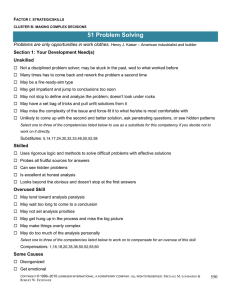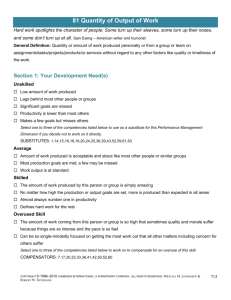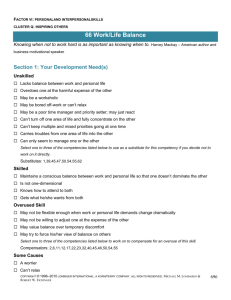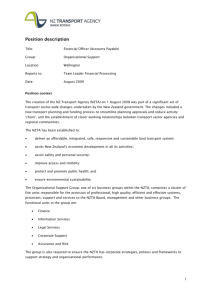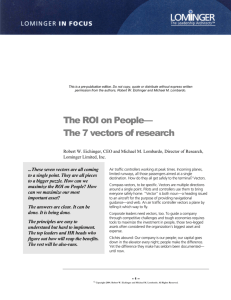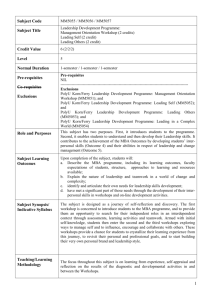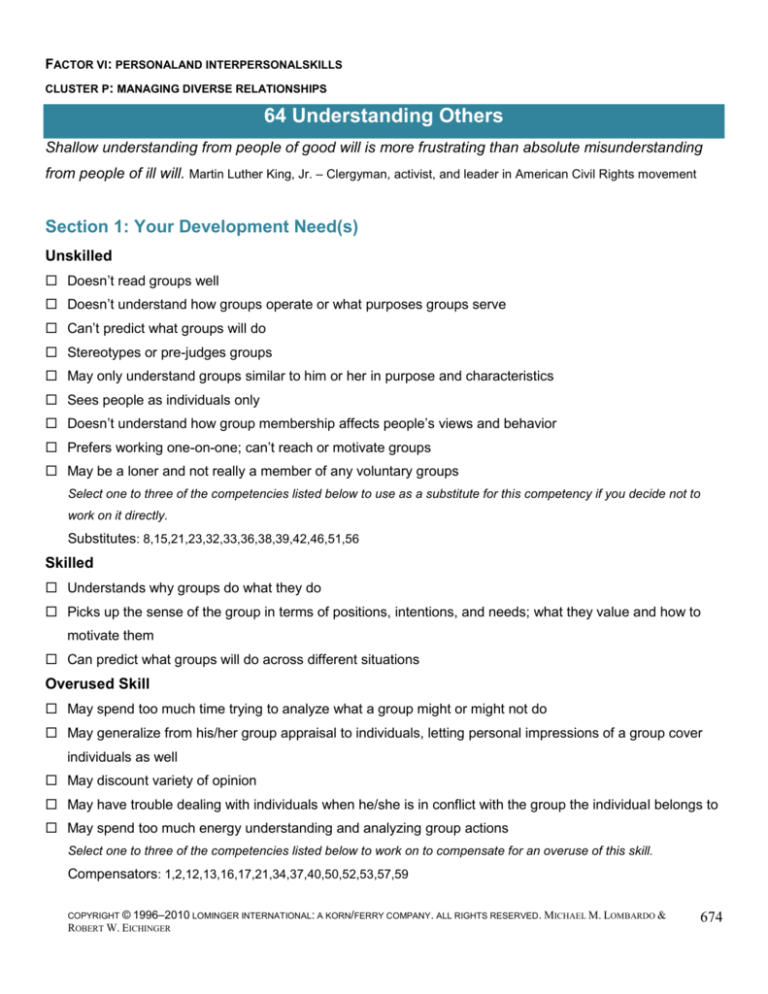
FACTOR VI: PERSONALAND INTERPERSONALSKILLS
CLUSTER P: MANAGING DIVERSE RELATIONSHIPS
64 Understanding Others
Shallow understanding from people of good will is more frustrating than absolute misunderstanding
from people of ill will. Martin Luther King, Jr. – Clergyman, activist, and leader in American Civil Rights movement
Section 1: Your Development Need(s)
Unskilled
Doesn’t read groups well
Doesn’t understand how groups operate or what purposes groups serve
Can’t predict what groups will do
Stereotypes or pre-judges groups
May only understand groups similar to him or her in purpose and characteristics
Sees people as individuals only
Doesn’t understand how group membership affects people’s views and behavior
Prefers working one-on-one; can’t reach or motivate groups
May be a loner and not really a member of any voluntary groups
Select one to three of the competencies listed below to use as a substitute for this competency if you decide not to
work on it directly.
Substitutes: 8,15,21,23,32,33,36,38,39,42,46,51,56
Skilled
Understands why groups do what they do
Picks up the sense of the group in terms of positions, intentions, and needs; what they value and how to
motivate them
Can predict what groups will do across different situations
Overused Skill
May spend too much time trying to analyze what a group might or might not do
May generalize from his/her group appraisal to individuals, letting personal impressions of a group cover
individuals as well
May discount variety of opinion
May have trouble dealing with individuals when he/she is in conflict with the group the individual belongs to
May spend too much energy understanding and analyzing group actions
Select one to three of the competencies listed below to work on to compensate for an overuse of this skill.
Compensators: 1,2,12,13,16,17,21,34,37,40,50,52,53,57,59
COPYRIGHT © 1996–2010 LOMINGER INTERNATIONAL: A KORN/FERRY COMPANY. ALL RIGHTS RESERVED. MICHAEL M. LOMBARDO &
ROBERT W. EICHINGER
674
Some Causes
A loner; not a joiner; hasn’t experienced groups
Dismiss the importance of groups
Don’t acknowledge groups
Don’t like people to form groups
Don’t understand how groups operate
Judgmental about other groups
Problems dealing with other functions/professions
See groups as stereotypes
Leadership Architect® Factors and Clusters
This competency is in the Personal and Interpersonal Skills Factor (VI). This competency is in the Managing
Diverse Relationships Cluster (P) with: 4, 15, 21, 23, 42. You may want to check other competencies in the
same Factor/Cluster for related tips.
The Map
By knowing what group or groups a person belongs to, you can get a better handle on what the person
believes, why, and what he or she might do in a given situation. Group members hold some but not all beliefs,
assumptions about the world, habits and practices in common. Members of groups look alike because likeminded people form and join groups and because groups educate and orient new members into the norms and
standards of the group.
Section 2: Learning on Your Own
These self-development remedies will help you build your skill(s).
Some Remedies
1. Need to understand volunteer groups? Study up on voluntary or advocacy groups. If it is a
voluntary/interest group, people usually belong for three reasons: The group fulfills social needs; provides a
sense of belonging, gives emotional support and identification; and helps people achieve their goals by
sharing information and helping each other. Groups are stronger than individuals and are natural to the
human species. Being a loner is not. Belonging to voluntary groups is exceptionally important to most as
they define our sense of what’s worthwhile to a great degree. People go in and out of informal voluntary
groups as their needs and interests change. Find out all you can about what groups people you need to
deal with and manage belong to. It can help you deal with them and help them perform better.
COPYRIGHT © 1996–2010 LOMINGER INTERNATIONAL: A KORN/FERRY COMPANY. ALL RIGHTS RESERVED. MICHAEL M. LOMBARDO &
ROBERT W. EICHINGER
675
2. Want to know why informal groups form? Study the history of group formation inside and
outside the organization. Voluntary groups generally form because of a common interest, challenge,
threat, or goal individual members can’t deal with by themselves. Unions were a reaction to oppressive
management. Civil Rights groups were a reaction to a lack of equal opportunities. The AMA was formed to
set standards for the medical profession and protect it from charlatans and snake oil salespersons. A group
of minorities might form inside your organization because they think they are being held to a double
standard and not being given enough opportunities. Especially inside your organization, watch what groups
and cliques form on their own. Try to work backward and determine why they formed. What groups do you
belong to? Why did you join?
3. Stereotyping group members? Don’t automatically lump people into categories. Some groups are
forced by an involuntary category. There are gender and racial groups. There are country of origin groups.
There is Mensa, limited by a high tested IQ. There is a national Bald Person’s Club. Any individual may or
may not choose to join and partake in the activities of the group. Other people, however, have a tendency
to stereotype people into their categorical groups, whether the person buys into that or not. While some
aspects of categorical groups might help you read people better, it is important not to lump people into
categories. First find out if they buy into the interests and practices of their category before you begin to
use that in your assessment of them.
4. Think all groups are the same? Know the difference between interest groups and
functional/professional ones. Other groups in organizations are not interest groups; they are nominal
functional/professional ones. They are formed to define and maintain the boundaries between one group—
accountants, and the other—marketers. Formal groups maintain entry standards and have membership
criteria. They support the development of specialized skills and help individual members succeed, guard
the group against attack from the outside, and lobby for beneficial legislation. Membership in these groups
is defined by your job, your organization’s method of organizing itself and your profession. If your job
changes, if you move from division A to division B, you will change nominal groups as soon as you cross
the border.
5. Looking for root causes of group behavior? Learn to be a cultural anthropologist. In assessing
groups, ask yourself what makes their blood boil? What do they believe? What are they trying to
accomplish together? What do they smile at? What norms and customs do they have? What practices and
behaviors do they share? Do they not like it if you stand too close? If you get right down to business? Do
they like first names or are they more formal? If a Japanese manager presents his card, do you know what
to do? Why do they have their cards printed in two languages and executives from the U.S. don’t? Do you
know what jokes are OK to tell? What do they believe about you and your group or groups? Positive?
COPYRIGHT © 1996–2010 LOMINGER INTERNATIONAL: A KORN/FERRY COMPANY. ALL RIGHTS RESERVED. MICHAEL M. LOMBARDO &
ROBERT W. EICHINGER
676
Neutral? Negative? What’s been the history of their group and yours? Is this a first contact or a long
history? Don’t blunder in; nothing will kill you quicker with a group than showing utter disregard for it and its
norms or having no idea of how they view your group. Ask people who deal with this group often for
insights. If it’s an important group to you and your business, read about it. More help? – See #21 Managing
Diversity.
6. Uncomfortable with some groups? Be candid with yourself. Is there a group or groups you don’t like or
are uncomfortable with? Do you judge individual members of that group without really knowing if your
impressions and stereotype is true? Most of us do. Avoid putting groups in good and bad buckets. Many of
us bucket groups as friendly or unfriendly. Once we do, we generally don’t talk to the unfriendliest as much
and may question their motives. Don’t generalize about individuals. A person might belong to a group for
many reasons, yet not typify stereotypes of the group. All accountants aren’t detail-driven introverts, for
example. To deal with this put yourself in their shoes. Why would you act that way? What do you think
they’re trying to achieve? Assume that however they act is rational; it must have paid off or they wouldn’t
be doing it. Describe behavior and motives as neutrally as you can. Listen and observe to understand, not
judge. If you are going to interact with a group you have trouble with, be on your guard and best behavior.
7. Unsure of who does what in groups? Identify the roles inside groups. All groups share a common set
of things that happen inside the group. Groups aren’t undifferentiated masses. Many errors in dealing with
groups involve failures in seeing groups as sets of roles. A commonly accepted typology of eight group
roles was developed by Belbin. You should know about it because spotting the role played tells you whom
to deal with as varying situations arise:
Leader.–– Shapes the way in which group efforts are applied by focusing priorities and direction.
Looked to when trouble comes.
Process Manager.–– Focuses on process needed to reach team objectives.
Innovator. ––Advances the new, challenges the old.
Evaluator.–– The analyst; sifts through problems for the group.
Finisher. ––Focuses on deadlines, commitments and urgency.
Work organizer.–– Turns plans into procedures and sequences.
Internal negotiator.–– Maintains relationships, builds team spirit.
External negotiator.–– Scans outside for resources, ideas, contacts for deal making.
Additionally there are gatekeepers who protect and manage entry, clowns who manage tension relief,
synergizers who bring disparate things together, enforcers who make sure members tow the line and so
forth. So in addition to knowing what group or groups a person belongs to, you need to know what role or
roles they play inside the group. Usually one person plays one role. Unless the group is very small or very
COPYRIGHT © 1996–2010 LOMINGER INTERNATIONAL: A KORN/FERRY COMPANY. ALL RIGHTS RESERVED. MICHAEL M. LOMBARDO &
ROBERT W. EICHINGER
677
hierarchical, you’re better off going to the person who’s most concerned with your issue or asking who that
might be. Use the group’s power. You will have little luck motivating a group by asking for something that
asks them to go against a core reason for being in the group. Your best bet is to appeal to the person who
plays the role you’re interested in to exercise his/her power and influence. What role or roles do you usually
play?
8. Want to effectively deal with groups? Interact with groups in ways with which they can relate. To
deal effectively with groups, establish reciprocity. Relationships don’t last unless you provide something
and so do they. Find out what they want and tell them what you want. Strike a bargain. If one group usually
gets the benefit, the other group will eventually become uncooperative and balky. Learn their conceptual
categories. People who went on to become successful executives often spoke of their first time dealing
with another function. The most common tack for a marketing person dealing with finance for the first time
was to show them something he/she was working on and ask them how they would analyze it. What
questions would they ask? What are the key numbers and why? What were the four or five key factors they
were looking at? Be able to speak their language. Speaking their language makes it easier for them to talk
with you and shows respect. Tell them your conceptual categories. To deal with you they also need to
know how you think and why. As in the tip above, tell them your perspective—the questions you ask, the
factors you’re interested in. If you can’t explain your thinking, they won’t know how to deal with you
effectively.
9. Impatient to get your message across? Avoid early solution statements and extreme positions.
While the answer might be obvious to you, and might make perfect sense to someone in your field, it may
either mean nothing or will be jarring to people in another function. Lay out your thinking, explain the
alternatives, and keep them as maybes. Then invite them to apply their perspective to it. If you fire out
solutions, you’ll encourage them to reply in your terms. You’ll never learn to understand them.
10. Is conflict between groups getting in the way? Get groups to work together. The keys are to find
the common ground, downsize the differences that will get in the way and use the differences that add
value to form an alliance. Even groups seemingly far apart will have some things in common. Announce
that you would first like to see if there are any points on which the two sides could tentatively agree. List
those on a board or flip chart. Then list the seemingly far aparts, the real differences. Take each difference
and list it as adding value—we can do that and you can’t, and you can do something we are not good at—
or getting in the way. Use the differences that add value and throw a plan around minimizing the
troublesome differences. Based on the common ground and the value adding differences, form a common
mindset about how these groups can work together more effectively. More help? – See #12 Conflict
Management.
COPYRIGHT © 1996–2010 LOMINGER INTERNATIONAL: A KORN/FERRY COMPANY. ALL RIGHTS RESERVED. MICHAEL M. LOMBARDO &
ROBERT W. EICHINGER
678
Section 3: Learning from Feedback
These sources would give you the most accurate and detailed feedback on your skill(s).
1. Human Resource Professionals
Human Resource professionals have both a formal and informal feedback role. Since they have access to
unique and confidential information, they can provide the right context for feedback you’ve received.
Sometimes they may be ―directed‖ to give you feedback. Other times, they may pass on feedback just to
be helpful to you.
2. Natural Mentors
Natural mentors have a special relationship with you and are interested in your success and your future.
Since they are usually not in your direct chain of com-mand, you can have more open, relaxed, and fruitful
discussions about yourself and your career prospects. They can be a very important source for candid or
critical feedback others may not give you.
3. Past Associates/Constituencies
When confronted with a present performance problem, some claim, ―I wasn’t like that before; it must be the
current situation.‖ When feedback is available from former associates, about 50% support that claim. In the
other half of the cases, the people were like that before and probably didn’t know it. It sometimes makes
sense to access the past to clearly see the present.
4. Peers and Colleagues
Peers and colleagues have a special social and working relationship. They attend staff meetings together,
share private views, get feedback from the same boss, travel together, and are knowledgeable about each
other’s work. You perhaps let your guard down more around peers and act more like yourself. They can be
a valuable source of feedback.
Section 4: Learning from Develop-in-Place Assignments
These part-time develop-in-place assignments will help you build your skill(s).
Integrate diverse systems, processes, or procedures across decentralized and/or dispersed units.
Go to a campus as a recruiter.
Go on a business trip to a foreign country you’ve not been to before.
Create employee involvement teams.
Work on a team forming a joint venture or partnership.
Manage a dissatisfied internal or external customer; troubleshoot a performance or quality problem with a
product or service.
COPYRIGHT © 1996–2010 LOMINGER INTERNATIONAL: A KORN/FERRY COMPANY. ALL RIGHTS RESERVED. MICHAEL M. LOMBARDO &
ROBERT W. EICHINGER
679
Resolve an issue in conflict between two people, units, geographies, functions, etc.
Write a speech for someone higher up in the organization.
Be a member of a union-negotiating or grievance-handling team.
Manage a project team of people who are older and more experienced than you.
Section 5: Learning from Full-Time Jobs
These full-time jobs offer the opportunity to build your skill(s).
1. Change Manager
The core demands to qualify as a Change Manager are: (1) Leader of a significant effort to change
something or implement something of significance. (2) Success and failure will be evident. (3) Always
something new and unique to the organi-zation. (4) Must get many others to buy in and cooperate. (5)
Involves cross-boundary change. (6) High visibility sponsor. (7) Exposure to significant decision makers
and key stakeholders. (8) Resistance is expected and near-universal. (9) Cost of failure is significant.
Examples include: (1) Total Work Systems like TQM, ISO, or Six Sigma. (2) Business restructurings like a
move away from a core competence and into a new product space or industry, i.e., American carmakers
move into smaller, more fuel-efficient products. (3) Installing major systems (like an ERP or HRIS) and
procedures for the first time. (4) M&A integrations, responding to major competitor initiatives that threaten
the organization. (5) Extensive reorganizations. (6) Long-term post-corporate scandal recovery.
2. Cross-Moves
The core demands necessary to qualify as a Cross-Move are: (1) Move to a very different set of
challenges. (2) Abrupt jump/shift in tasks/activities. (3) Never been there before. (4) New setting/conditions.
Examples of Cross-Moves are: (1) Changing divisions. (2) Changing functions. (3) Field/headquarters
shifts. (4) Line/staff switches. (5) Country switches. (6) Working with all new people. (7) Changing lines of
business.
3. Line to Staff Switches
The core demands to qualify as a Line to Staff switch are: (1) Intellectually/strategically demanding. (2)
Highly visible to others. (3) New area/perspective/method/culture/function. (4) Moving away from a bottom
line. (5) Moving from field to headquarters. (6) Exposure to high-level executives. Examples: (1)
Business/strategic planning. (2) Heading a staff department. (3) Assistant to/chief of staff to a senior
executive. (4) Head of a task force. (5) Human resources role.
COPYRIGHT © 1996–2010 LOMINGER INTERNATIONAL: A KORN/FERRY COMPANY. ALL RIGHTS RESERVED. MICHAEL M. LOMBARDO &
ROBERT W. EICHINGER
680
4. Staff Leadership (Influencing Without Authority)
The core demands to qualify as Staff Leadership are: (1) Significant challenge (e.g., start-up, fix-it, scope
and/or scale assignment, strategic planning project, changes in management practices/systems). (2)
Insufficient direct authority to make it happen. (3) Tight deadlines. (4) Visible to significant others. (5)
Sensitive politics. Examples of Staff Leadership (Influencing Without Authority) jobs would be: (1) Leading
a support function without P&L responsibilities. (2) Managing an internal consulting function for the
organization (e.g., OD or HR consultant). (3) Project manager of a cross-functional or cross-departmental
initiative. (4) Managing a cross-functional, matrixed team.
Section 6: Learning from Your Plan
These additional remedies will help make this development plan more effective for you.
Learning to Learn Better
1. Form a Learning Network with Others Working on the Same Problem
Look for people in similar situations, and create a process for sharing and learning together. Look for a
variety of people inside and outside your organization. Give feedback to each other; try new and different
things together; share successes, failures, and lessons.
2. Use Objective Data When Judging Others
Practice studying other people more than judging or evaluating them. Get the facts, the data, how they
think, why they do things—without classifying them into your internal like/dislike or agree/disagree boxes,
categories, or buckets. Try to project or predict how they would act/react in various situations, and follow up
to see how accurate you are.
3. Examine Why You Judge People the Way You Do
List the people you like and those you dislike and try to find out why. What do those you like have in
common with each other and with you? What do those you dislike have in common with each other and
how do they differ from you? Are your ―people buckets‖ logical and productive or do they interfere? Could
you be more effective without putting people into buckets?
4. Debrief Someone Else After a Successful or Non-Successful Event
Shortly after someone does something particularly well or badly, debrief them on the process they followed.
Ask them about the decisions they made and why; find out what they would have done differently. See if
you can glean some insights or rules of thumb from the experiences of others.
COPYRIGHT © 1996–2010 LOMINGER INTERNATIONAL: A KORN/FERRY COMPANY. ALL RIGHTS RESERVED. MICHAEL M. LOMBARDO &
ROBERT W. EICHINGER
681
5. Pre-Sell an Idea to a Key Stakeholder
Identify the key stakeholders—those who will be the most affected by your actions or the most resistant, or
whose support you will most need. Collect the information each will find persuasive; marshal your
arguments and try to pre-sell your conclusions, recommendations, and solutions.
6. Sell Something to a Tough Group/Audience
Think of the person or group who will be the toughest to sell, the most critical, skeptical, or resistant, and
sell that person or group first. Take time to understand the opposing viewpoints. Find common ground and
leverage points; line up your best data and arguments and go for it.
Learning from Experience, Feedback, and Other People
7. Using Multiple Models
Who exemplifies how to do whatever your need is? Who, for example, personifies decisiveness or
compassion or strategic agility? Think more broadly than your current job and colleagues. For example,
clergy, friends, spouses, or community leaders are also good sources for potential models. Select your
models not on the basis of overall excellence or likeability, but on the basis of the one towering strength (or
glaring weakness) you are interested in. Even people who are well thought of usually have only one or two
towering strengths (or glaring weak-nesses). Ordinarily, you won’t learn as much from the whole person as
you will from one characteristic.
8. Learning from a Coach or Tutor
Ask a person to coach or tutor you directly. This has the additional benefit of skill building coupled with
correcting feedback. Also observe the teacher teaching you. How does he/she teach? How does he/she
adjust to you as a learner? After the process, ask for feedback about you as a learner.
9. Consolidating What You Learn from People
After using any source and/or method of learning from others, write down or mentally note the new rules of
thumb and the principles involved. How will you remind yourself of the new behaviors in similar situations?
How will you prevent yourself from reacting on ―autopilot‖? How could you share what you have learned
from others?
When you learn something from people, or from a culture, you accept it as a gift, and it is your lifelong
commitment to preserve it and build on it. Yo-Yo Ma – French-born Chinese-American cellist and Grammy Award
winner
COPYRIGHT © 1996–2010 LOMINGER INTERNATIONAL: A KORN/FERRY COMPANY. ALL RIGHTS RESERVED. MICHAEL M. LOMBARDO &
ROBERT W. EICHINGER
682
Suggested Readings
Ashkenas, R. N., Ulrich, D., Jick, T., & Kerr, S. (2002). The boundaryless organization: Breaking the chains of
organization structure (Rev. ed.). San Francisco: Jossey-Bass.
Belbin, R. M. (2004). Management teams (2nd ed.). Boston: Butterworth-Heinemann.
Beyerlein, M. M., Freedman, S., McGee, C., & Moran, L. (2002). Beyond teams: Building the collaborative
organization. San Francisco: Jossey-Bass.
Cohen, D., & Prusak, L. (2001). In good company: How social capital makes organizations work. Boston:
Harvard Business School Press.
Deresky, H. (2002). Global management: Strategic and interpersonal. Upper Saddle River, NJ: Prentice Hall.
Greenhalgh, L. (2001). Managing strategic relationships: The key to business success. New York: Free Press.
Lancaster, L. C., Stillman, D., & MacKay, H. (2002). When generations collide: Who they are. Why they clash.
How to solve the generational puzzle at work. New York: HarperCollins.
Lawrence, P. R., & Nohria, N. (2002). Driven: How human nature shapes our choices. San Francisco: JosseyBass.
Lee, Y. T., Jussim, L. J., & McCauley, C. R. (Eds.). (1995). Stereotype accuracy: Toward appreciating group
differences. Washington, DC: American Psychological Association.
Lewis, R. D. (2006). When cultures collide: Leading across cultures (3rd ed.). Boston: Nicholas Brealey.
Maginn, M. (2004). Making teams work: 24 Lessons for working together successfully. New York: McGraw-Hill.
Maister, D. H. (2001). Practice what you preach: What managers must do to create a high-achievement
culture. New York: Free Press.
Middleton, D. R. (2002). The challenge of human diversity: Mirrors, bridges, and chasms. Prospect Heights, IL:
Waveland Press.
Miller, F. A., & Katz, J. H. (2002). The inclusion breakthrough. San Francisco: Berrett-Koehler Publishers.
Tomalin, B., & Nicks, M. (2007). The world‘s business cultures and how to unlock them: Special chapters on
China, USA, Germany, UK, Russia, India, Brazil, France, Italy, and Japan. London: Thorogood.
Underwood, C. (2007). The generational imperative: Understanding generational differences in the workplace,
marketplace, and living room. Charleston, SC: BookSurge.
COPYRIGHT © 1996–2010 LOMINGER INTERNATIONAL: A KORN/FERRY COMPANY. ALL RIGHTS RESERVED. MICHAEL M. LOMBARDO &
ROBERT W. EICHINGER
683

